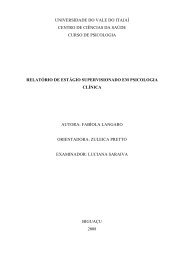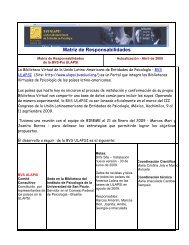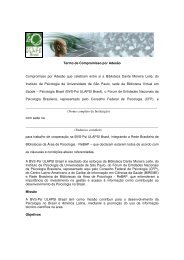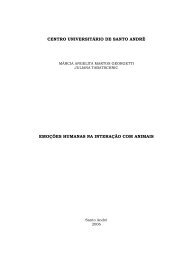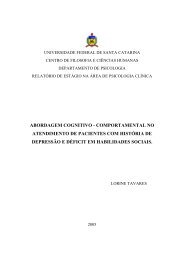- Page 1:
ISSN 1667-6750Universidad de Buenos
- Page 5:
índice de áreasTOMO IPsicología
- Page 8 and 9:
LA DESATENCIÓN Y LA HIPERACTIVIDAD
- Page 10 and 11:
DE LA MOTIVACIÓN A LA IMPLICACIÓN
- Page 12 and 13:
CORRECCIONES A EXÁMENES ESCRITOS E
- Page 14 and 15:
MEDIAR LOS MEDIOS EN LA ESCUELA. AL
- Page 16 and 17:
PERFILES DE LECTURA Y ESCRITURA EN
- Page 18 and 19:
FILOSOFÍA Y EPISTEMOLOGÍATRABAJOS
- Page 22 and 23:
yugo de una economía de mercado y
- Page 24 and 25:
PERFECCIONISMO ADAPTATIVO Y DESADAP
- Page 26 and 27:
LA OBSERVACIÓN, HERRAMIENTAEN LA F
- Page 28 and 29:
estuve volando, no escribas esto qu
- Page 30 and 31:
contexto sin entretejerse con su mu
- Page 32 and 33:
cuentran diversas barreras. Cada ve
- Page 34 and 35:
PROCESO PSICOTERAPÉUTICO:ESTUDIO D
- Page 36 and 37:
su padre.Al inicio Susana manifiest
- Page 38 and 39:
mayores, en el otro la mujer y en e
- Page 40 and 41:
RESULTADOS PRELIMINARES DEL PROYECT
- Page 42 and 43:
PERFIL PSICOPATOLÓGICO DEUNA POBLA
- Page 44 and 45:
personalidad. Barcelona: Paidós.BE
- Page 46 and 47:
de terror, el brazo le temblaba y l
- Page 48 and 49:
NO SOY YO, ES ELLA. EL MOTIVO DE CO
- Page 50 and 51: padres. Al respecto encontramos que
- Page 52 and 53: esta forma, la selección natural n
- Page 54 and 55: LA SEXUALIDAD FEMENINAA PARTIR DEL
- Page 56 and 57: adical en lo atinente a la conceptu
- Page 58 and 59: METODOLOGÍANos hemos propuesto tra
- Page 60 and 61: versas, las FMP en riesgo social te
- Page 62 and 63: EN TORNO A LA PLENITUD SEXUAL: BÚS
- Page 64 and 65: DOUGLAS, M. 1998. Estilos de Pensar
- Page 66 and 67: A veces, lo que predomina es la dif
- Page 68 and 69: EL ENFOQUE CIENTíFICOEN LA PSICOTE
- Page 70 and 71: TERAPIA COGNITIVA Y YOGA. LA INCLUS
- Page 72 and 73: IMPACTO DE LAS CATEGORíAS CULTURAL
- Page 74 and 75: (DSM-IV) en contextos intercultural
- Page 76 and 77: psicoterapia psicoanalítica de gru
- Page 78 and 79: AUTOLESIONES DELIBERADAS -DSH-,UNA
- Page 80 and 81: POSIBLES SALIDAS DE LA SIMBIOSISMen
- Page 82 and 83: Bill: Estoy en el Japón, en el cam
- Page 84 and 85: por información general (lugar de
- Page 86 and 87: algo o desentenderse de ello es asu
- Page 88 and 89: CLíNICA DIFERENCIAL DE LAS PERTURB
- Page 90 and 91: cobra importancia en las discusione
- Page 92 and 93: TRASTORNOS DEL LENGUAJE EN EL ESPEC
- Page 94 and 95: cumple, en el hombre, la función d
- Page 96 and 97: psíquica, históricamente constitu
- Page 98 and 99: LA DEPRESIÓN DESDELA PSICOLOGÍA E
- Page 102 and 103: PRESENTACIÓN DEL DISPOSITIVO PSICO
- Page 104 and 105: MANIFESTACIONES DE LA VIOLENCIAEN A
- Page 106 and 107: específicos y eficaces de interven
- Page 108 and 109: eside en el conjunto de caracterís
- Page 110 and 111: TRASTORNOS ALIMENTARIOS EN ESTUDIAN
- Page 112 and 113: con aquellos que no presentan riesg
- Page 114 and 115: situación que aún llena de orgull
- Page 116 and 117: LO DELUSIONAL OEL SIMBOLISMO DESARR
- Page 118 and 119: en uno, sin sentir que la sombra de
- Page 120 and 121: otro de la escena que no avanza sob
- Page 122 and 123: EVALUACIÓN DE DIFERENCIAS EN LOS R
- Page 124 and 125: Lugar. Incluye Protocolo de Logro d
- Page 126 and 127: comunicación no verbal de las nece
- Page 128 and 129: emoción-abstracción al enfoque cl
- Page 130 and 131: PERFIL DE LOS RESIDENTES EN SALUD M
- Page 132 and 133: Organización Mundial de la Salud (
- Page 134 and 135: de preguntas se refiere a “trasto
- Page 136 and 137: PERFIL COGNITIVO DE PACIENTES CON T
- Page 138 and 139: posee una excelente validez y confi
- Page 140 and 141: historia de mis maduraciones y regr
- Page 142 and 143: APLICACIÓN DE UN MODELO DE RESOLUC
- Page 144 and 145: LA ALIANZA TERAPÉUTICA Y SU INTERA
- Page 146 and 147: Líneas potenciales de investigaci
- Page 149 and 150: HACIA UNA HERMENÉUTICA DELCASO BIL
- Page 151:
posters
- Page 155:
Psicología del Trabajo
- Page 158 and 159:
ecibidos de las carreras de Psicolo
- Page 160 and 161:
GESTIÓN DEL CAMBIO EMPRESARIAL Y L
- Page 162 and 163:
cambio debe ser traducida y deconst
- Page 164 and 165:
dad, se observa que los hombres obt
- Page 166 and 167:
TRABAJO PRECARIOMosso, Elba; Carri,
- Page 168 and 169:
investigaciones dan cuenta que la m
- Page 170 and 171:
condiciones previstas en los artíc
- Page 172 and 173:
nación por Embarazo de 1978, y la
- Page 174 and 175:
INSTITUCIONES DEL ESTADO:TRANSFORMA
- Page 176 and 177:
esultados, y finalmente, el siempre
- Page 178 and 179:
Boltanski y Chiapello (2002: 97 y s
- Page 180 and 181:
PADECIMIENTOS EN EL TRABAJO YSU VIN
- Page 182 and 183:
[VIII] Entendemos a la “adaptaci
- Page 185:
CLIMA ORGANIZACIONALEN ORGANIZACION
- Page 189 and 190:
DESGASTE PROFESIONAL, N-ACH Y EXPEC
- Page 191 and 192:
[3] Las últimas cifras oficiales r
- Page 193 and 194:
Lo dicho resulta relevante por sus
- Page 195 and 196:
se han encontrado diferencias signi
- Page 197 and 198:
0,001), psicológica (p = 0,01) y p
- Page 199:
esúmenes
- Page 203:
PSICOLOGÍA EDUCACIONAL YORIENTACI
- Page 206 and 207:
siempre constituyen un medio de vid
- Page 208 and 209:
BIBLIOGRAFÍAAisenson, D.; Aisenson
- Page 210 and 211:
llándose en la vida adulta, y en c
- Page 212 and 213:
INCIDENCIA DE LOS VALORES EN LA ELE
- Page 214 and 215:
LAS HABILIDADES PRELECTORAS YSU ASO
- Page 216 and 217:
UNA PROPUESTA DE APRENDIZAJEDENTRO
- Page 218 and 219:
prejuicios a la hora de pensar las
- Page 220 and 221:
contudo, fragmentá-la uma vez que
- Page 222 and 223:
CAMBIOS EN LA MADUREZ VOCACIONALDUR
- Page 224 and 225:
POSIBILIDADES PREVENTIVAS DE LA UTI
- Page 226 and 227:
LA ENSEÑANZA Y EL APRENDIZAJEEN EL
- Page 228 and 229:
EL DESGASTE LABORAL DE LOS MAESTROS
- Page 230 and 231:
la educación inicial.Participan ta
- Page 232 and 233:
un otro con capacidad de aprendizaj
- Page 234 and 235:
estitutivos y elaborativos que apar
- Page 236 and 237:
te que te manda cualquiera, y vos t
- Page 238 and 239:
profundizar, de analizar y comprend
- Page 240 and 241:
ADOLESCENTES EN CONTEXTOS CRÍTICOS
- Page 242 and 243:
vocacionales, si la consideramos en
- Page 244 and 245:
• Encuestas a docentes de escuela
- Page 246 and 247:
LOS JÓVENES Y EL PROYECTO EDUCATIV
- Page 248 and 249:
mación completa y fiable acerca de
- Page 250 and 251:
La estimación de las Distancias Se
- Page 252 and 253:
mientos, habilidades, actitudes, va
- Page 254 and 255:
LA CONSTRUCCIÓN DEL CONOCIMIENTO E
- Page 256 and 257:
Respecto a los obstáculos en el pr
- Page 258 and 259:
1. Pensamiento y Solución de probl
- Page 260 and 261:
dificulta aún más la detección d
- Page 262 and 263:
PRáCTICAS FORMALES E INFORMALES DE
- Page 264 and 265:
En lo relativo a sus escuelas todos
- Page 266 and 267:
los recursos informativos. Se reali
- Page 268 and 269:
OBJETIVOSa. Estudiar las diferencia
- Page 270 and 271:
¿QUÉ PIENSAN LOS MAESTROS SOBRE E
- Page 272 and 273:
que es el constructivismo. Sino des
- Page 274 and 275:
da con la enseñanza. Pero, para qu
- Page 276 and 277:
LAS REPRESENTACIONES SOCIALESY SU I
- Page 278 and 279:
ASPECTOS NARCISISTAS IMPLICADOS EN
- Page 280 and 281:
HACIA LA CONSTRUCCIÓN DE LA INTERV
- Page 282 and 283:
elacionarse con los dispositivos pe
- Page 284 and 285:
sionales de la Facultad de Psicolog
- Page 286 and 287:
ENGESTRÖM, Y. (2001) “Expansive
- Page 288 and 289:
la creciente desactualización de l
- Page 290 and 291:
mente en las consignas escritas[2].
- Page 292 and 293:
PENSAMIENTO CREATIVO Y LA GESTIóN
- Page 294 and 295:
tación de docentes universitarios
- Page 296 and 297:
técnicos de la psicología. Parale
- Page 298 and 299:
los aportes individuales, también
- Page 300 and 301:
Diker y Terigi (1997), reconocen ta
- Page 302 and 303:
PENSAMIENTO CREATIVOY ZONA DE INHIB
- Page 304 and 305:
CALLEJO, J. (2000): El grupo de dis
- Page 306 and 307:
pida por el golpe militar (llamado
- Page 308 and 309:
formación académica del psicólog
- Page 310 and 311:
peores puntos de partida.A pesar de
- Page 312 and 313:
PENSAMIENTO CREATIVO Y ZONA DE INHI
- Page 314 and 315:
operan con fuerza. En la enseñanza
- Page 316 and 317:
positivamente la implementación de
- Page 318 and 319:
se interpretará la innovación; y
- Page 320 and 321:
del problema con relación a la Psi
- Page 322 and 323:
DESARROLLO DE LA METODOLOgíA BIMOD
- Page 324 and 325:
Para llevar a cabo este estudio se
- Page 326 and 327:
habilitar el desasimiento de los ob
- Page 328 and 329:
involucrado en la situación que la
- Page 330 and 331:
DELVAL, J., Del BARRIO, C., ESPINOS
- Page 332 and 333:
incluirían: sexo, edad, rasgos de
- Page 334 and 335:
CONCEPCIONES DE ENSEÑANZA E INTERA
- Page 336 and 337:
queños, localizados en diferentes
- Page 338 and 339:
simbólico y lo imaginario. Lo grup
- Page 340 and 341:
DISCURSOS, MODELOS Y VIOLENCIAEN LA
- Page 342 and 343:
ARTICULACIóN - ORIENTACIóN VOCACI
- Page 344 and 345:
LA INTERVENCIóN INSTITUCIONAL COMO
- Page 346 and 347:
BIBLIOGRAFÍABOGDAN, R. & BIKLEN, S
- Page 348 and 349:
El objetivo general de la propuesta
- Page 350 and 351:
LAS REPRESENTACIONES SOCIALES DELAS
- Page 352 and 353:
Hamburgo, N° 137.BAQUERO, R. y F.
- Page 354 and 355:
85% desconocía a los candidatos po
- Page 356 and 357:
MUNDOS POSIBLES Y CONSTRUCCIÓN SEM
- Page 358 and 359:
pues son múltiples las voces que d
- Page 360 and 361:
se produce en el salón de clases d
- Page 362 and 363:
mada y ampliada por Marton, Dall Al
- Page 364 and 365:
2- la forma de organizar la activid
- Page 366 and 367:
FORMACIóN Y CRITERIOS TEÓRICO-CL
- Page 368 and 369:
TRABAJOS DE LOS JóVENES PARASU INS
- Page 370 and 371:
EL PROBLEMA DEL CAMBIO CONCEPTUALEN
- Page 372 and 373:
acomodado” es “el objeto”,
- Page 374 and 375:
como una descripción de las actitu
- Page 376 and 377:
educativa en general- el desarrollo
- Page 378 and 379:
sujeto en la pubertad quien junto a
- Page 380 and 381:
¿Qué sentido adquieren tales sabe
- Page 382 and 383:
ESTILOS ATRIBUCIONALES CAUsALES YRE
- Page 384 and 385:
BIBLIOGRAFÍABARCA L.; ALFONSO, (20
- Page 386 and 387:
otros 16%. En cuanto a los criterio
- Page 388 and 389:
hacer síntesis en respuestas que s
- Page 390 and 391:
de Psicólogos), como AUAPsi y UVAP
- Page 392 and 393:
DI DOMÉNICO, C. & VILANOVA, A. (Ed
- Page 394 and 395:
una de las etapas del trabajo que d
- Page 396 and 397:
existe con un régimen de promoció
- Page 398 and 399:
Desde la implementación de la herr
- Page 400 and 401:
hipótesis clásicas: (1) la superi
- Page 402 and 403:
Estudio de casos: Para ejemplificar
- Page 404 and 405:
querés.(Rodrigo) Porque el buscado
- Page 406 and 407:
PENSAMIENTO CREATIVO COMO HERRAMIEN
- Page 408 and 409:
tiva?”, México. Benemérita Univ
- Page 410 and 411:
entre otros (Whiterhurst & Lonigan,
- Page 412 and 413:
PROFESIONALES MÉDICOS MAYORES:¿AC
- Page 414 and 415:
ACTUALIZACIÓN E INFORMATIZACIÓNDE
- Page 416 and 417:
BIBLIOGRAFÍAAISENSON, D. (2002). D
- Page 418 and 419:
palabras, por lo tanto no pueden re
- Page 420 and 421:
LOS TALLERES DE REFLEXIóN E INFORM
- Page 422 and 423:
taller, no cesa de asombrarnos la d
- Page 424 and 425:
en la escritura correcta. De tal mo
- Page 426 and 427:
OBSERVACIONES ACERCA DE LAS DIFICUL
- Page 428 and 429:
p.2394)(4)Los mismos autores se pre
- Page 430 and 431:
• Zona de procedencia del niño/a
- Page 432 and 433:
PALABRAS EXTRANJERAS:ESCUELA Y COMP
- Page 434 and 435:
KRISTEVA, J. (1993): “Sentido y s
- Page 436 and 437:
Otras necesidades se relacionan con
- Page 438 and 439:
Hasta no hace más de dos décadas,
- Page 440 and 441:
de La Plata.ROMERO, H. (2004) “La
- Page 442 and 443:
el año 2002 al 2005.Los Criterios
- Page 444 and 445:
HILL, WINIFRED: Teorías contempor
- Page 446 and 447:
fazer a melhor cópia possível do
- Page 448 and 449:
iguales en número, los que reúnen
- Page 450 and 451:
transgredirlas. Ciertamente, la uni
- Page 452 and 453:
EL PSICÓLOGO SITUADOSipes, Marta;
- Page 454 and 455:
equiere como condición de posibili
- Page 456 and 457:
Pode-se relacionar o conhecer com a
- Page 458 and 459:
necessidades educativas e aprendiza
- Page 460 and 461:
provocados pelos fatos, os fluxos e
- Page 462 and 463:
LAS CONCEPCIONES DE LOS INGRESANTES
- Page 464 and 465:
se aprende en la vida y para la vid
- Page 466 and 467:
2.- Tradicional: en los que no se i
- Page 468 and 469:
nueva Convención sobre los Derecho
- Page 470 and 471:
ESTUDIO DE LA RELACIÓN ENTRE LA AC
- Page 472 and 473:
LAS CONCEPCIONES DE LOS DOCENTESACE
- Page 474 and 475:
Personalidad, inteligenciay desempe
- Page 476 and 477:
significativas tan sólo para la ex
- Page 478 and 479:
sentación que éstos elaboran acer
- Page 480 and 481:
procesos de composición escrita. E
- Page 482 and 483:
ciones a lo largo del tiempo.[i] En
- Page 484 and 485:
LOS TALLERES PREVENTIVOS:UNA EXPERI
- Page 486 and 487:
De lo relatado por los alumnos lueg
- Page 488 and 489:
los estudiantes realizan para apren
- Page 490 and 491:
producción textual, aún en perío
- Page 492 and 493:
INCIDENCIA DEL CONTEXTO SOCIAL EN L
- Page 494 and 495:
superiores.• Al momento de priori
- Page 497 and 498:
EXPERIENCIA DE INGRESO A LACARRERA
- Page 499 and 500:
CONSTRUCCIóN DEL RELATOHISTORICO E
- Page 501:
PROYECTOS VOCACIONALESDE JÓVENES D
- Page 505 and 506:
COMPARACIÓN ENTRE UN SET DE EVALUA
- Page 507 and 508:
EVALUACIÓN DE UN PLAN DE INTERVENC
- Page 509 and 510:
REPRESENTACIONES, SUJETOS Y PRÁCTI
- Page 511 and 512:
EL JUEGO DE LOS NIÑOS Y LOS ADOLES
- Page 513 and 514:
diagnóstico y tratamiento”. Vol.
- Page 515:
frimento e da dor que simbolizará
- Page 519 and 520:
DETERMINANTES INSTITUCIONALES INVOL
- Page 521 and 522:
REPRESENTACIÓN DE PELIGROSIDADEN L
- Page 523 and 524:
histórica”, Ed Depalma, Bs As. 1
- Page 525 and 526:
sino avanzar en la consideración d
- Page 527 and 528:
INSTITUCIONALIZACIóN VS. DESINSTIT
- Page 529 and 530:
DELEUZE, G.; GUATTARI, F. (2002) Mi
- Page 531 and 532:
cuencia necesaria: ante la real exi
- Page 533 and 534:
ESTUDIO CUALITATIVOPERCEPCIÓN DE V
- Page 535 and 536:
• El respeto por el tiempo del us
- Page 537 and 538:
epresentaciones y prácticas del si
- Page 539 and 540:
VISIBILIDAD Y ENUNCIADOS ACERCA DE
- Page 541 and 542:
en Psicólogos Institucionales Trab
- Page 543 and 544:
ción directa a los temas de conoci
- Page 545 and 546:
que podríamos llamar de la incestu
- Page 547 and 548:
significaciones para un sujeto, se
- Page 549 and 550:
LIBERTAD CONDICIONAL: ESTUDIO DE LA
- Page 551 and 552:
sentimientos provocados por una cri
- Page 553 and 554:
a) cuidar a sus pacientes atendiend
- Page 555 and 556:
VARIABLES JURÍDICASEN LA PRÁCTICA
- Page 557 and 558:
actos para propiciar el tránsito h
- Page 559 and 560:
al profesional desde el primer mome
- Page 561 and 562:
DA DOUTRINA DE VIGILÂNCIAÀ DOUTRI
- Page 563 and 564:
endemos o papel do educador no abri
- Page 565 and 566:
LA CONSTRUCCIÓN SOCIAL DE ESTEREOT
- Page 567:
Abrir interrogantes acerca de las f
- Page 571 and 572:
LA PRÁCTICA FORENSE EN EL GABINETE
- Page 573 and 574:
ACERCA DE LOS DERECHOS DE NIÑOS, N
- Page 575:
Filosofía y Epistemología
- Page 578 and 579:
científica, que es la máxima expr
- Page 580 and 581:
Husserl afirma, por su parte, que s
- Page 582 and 583:
LA CULTURA EN LA PSICOLOGÍA DEL DE
- Page 584 and 585:
IMAGINISTAS VERSUS ANTI-IMAGINISTAS
- Page 586 and 587:
generación -de raigambre conexioni
- Page 588 and 589:
Desde su perspectiva, los sistemas
- Page 590 and 591:
HACIA UNA ÉTICA INTERCULTURALEN LA
- Page 592 and 593:
ACERCA DEL CONCEPTO DE SUBLIMACIóN
- Page 594 and 595:
aquello que trata de significarse e
- Page 596 and 597:
ASIMETRÍA EN LA RELACIÓN INVESTIG
- Page 598 and 599:
contexto la aceptación o el rechaz
- Page 600 and 601:
las demandas e invitaciones especí
- Page 602 and 603:
RELACIÓN ENTRE LAS CATEGORÍAS DE
- Page 604 and 605:
sobre la articulación de lo Real c
- Page 607:
Memorias de las XIV Jornadas de Inv



